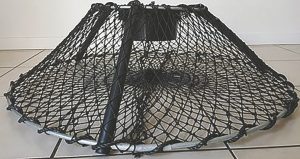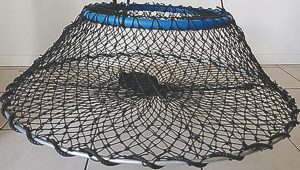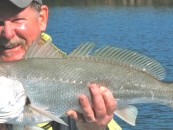Crabbing in South East Queensland
Jeff Hayes interview by Andy Kancachian
Going crabbing can be very rewarding at times when the fish are not biting. This means you can always go home with a few crabs for dinner, without the shame of arriving home empty-handed.
Crabs can be found along the entire Queensland coast, offshore to large open bays, from sheltered estuaries to tidal flats, and the mouths of rivers lined with mangroves. The most common crabs to catch in South East Queensland waterways are sand crabs or blue swimmer crabs, mud crabs, and spanner crabs.
TYPES OF CRAB POTS
The choice regarding short-time or long-time pots really depends on the individual, and the style and time allowable to be crabbing.
 To catch mud crabs and blue swimmer crabs, a short-time drop pot or an overnight pot can be used. For short-time pots, a recommended period of time can be 20 minutes to half an hour. The advantage of a short-time pot is that once you find a productive area, you can consistently catch more crabs while staying close to the pots to avoid anyone else checking or stealing your pots, which might occur in some areas.
To catch mud crabs and blue swimmer crabs, a short-time drop pot or an overnight pot can be used. For short-time pots, a recommended period of time can be 20 minutes to half an hour. The advantage of a short-time pot is that once you find a productive area, you can consistently catch more crabs while staying close to the pots to avoid anyone else checking or stealing your pots, which might occur in some areas.
An overnight pot can be left for a long period of time, which can be set from a boat or from the shoreline. The fact that they are in the water for an extended period of time can mean they will catch more crabs.
BAIT AND STRATEGY
The best bait to use is mullet, whiting frames, or bream frames. Several of the more experienced crab catchers stay away from bait such as a can of catfish and flathead frames. It is advisable to always have fresh bait to fill your pots, and work your pots in different areas to increase your chances of success.
The best strategy to catch sand crabs is to set your pots at 2 hours from the end of the run-out tide, or from 2 hours of the run-in tide. The mud crabs love the run-in tide. If you are using a short-time crab pot, move your drop pots every 20 minutes to half an hour, depending on how quick you are catching crabs.
If you are out fishing, drifting the sand banks for whiting, bream and flathead, you may also find sand crabs, particularly off the drop-off of the sand banks. You can drop your pots off a deep edge, then drift fish along the flats for about 20 minutes to half an hour, before drifting over the bank into the deep. Then check your pots, before repeating.
Once you catch your crabs, be careful not get ripped by them. When picking up a crab, you have to be quick. Stand behind the crab while pushing down on top of shell with other hand, and pick it up by the back flippers at the back of shell. The best thing to do to keep them fresher is to throw them straight into ice slurry as soon as you catch a crab. This will slow them down a bit and allow you to handle them easier.
The company manufactures a range of “throw-and-go” pots, a short-time drop pot, and a popular all-nighter pot. These pots need no assembly at all with the unique patented top ring flotation design. This floating ring lifts the netting to its assembled position, when thrown in the water. So, all you do is bait up and throw out.
Hayes Pots have been developed and perfected over the past four years. The pots are sold in over 50 stores across Australia. The Hayes Pots have proven their value in the market place with their unique floating ring tube design, and A-grade quality, strength, performance and price. They are made from high-quality UV-proof PE netting, strong 3mm thick poly tubing, extra strong 6mm- 10mm hot-dipped galvanised rings, 6mm rope wrapping all rings for added strength, and the all-round 360 degrees of access for crabs, in the perfect volcano-shaped design.
FISHERIES RULES
A maximum number of four pots, dillies or a combination of both may be used on a boat per person when on the water. You must have an identification tag on your pots bearing the surname and address of the person using the apparatus. The size and quantity limits for the blue swimmer crab is 11.5cm minimum and a limit of 20. For mud crabs, it is 15cm minimum and a limit of 7 per person or 14 per boat (with 2 or more people on board). For spanner crabs, it is 10cm minimum and a limit of 20 crabs. A closed season applies to the spanner crab species. For the three-spot crab it is a 10cm minimum. Female mud crabs and blue swimmer crabs are no-take species. Egg-bearing spanner crabs and three-spot crabs are also no-take crabs.
The easiest way to cook a bucket of crabs is to boil up a pot of fresh ocean water. Once the water comes to a boil, drop your crabs in. For sand crabs, the suggested cooking time is 7mins, while for mud crabs, it is 10-12 minutes. As soon as time is up, pick them up with tongs and put them straight into ice slurry to immediately stop them cooking any further. This supposedly shocks the meat and stops it from sticking to the sides of the shell.





























